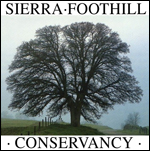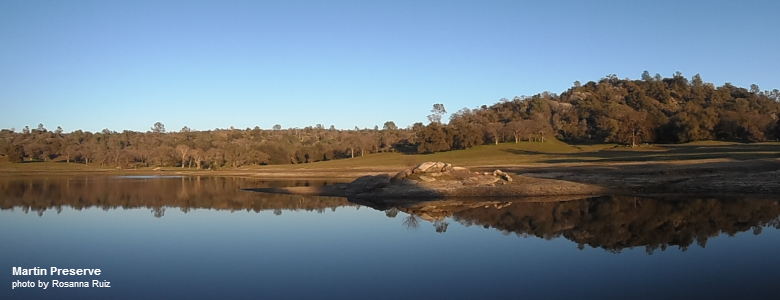Quarterly Newsletters
Join Today to get the latest Foothill Advocate. Previous newsletters (pdf format) can be downloaded below:
SFC Articles
“Stookey Restoration” by Greg Little
“The Mother of Conservation Efforts: Hornitos Ranch” by Greg Little (pdf)
“Sierra Foothill Conservancy 25th Anniversary” Video by Jeff Aiello
“Ah Spring on the McKenzie!” by Caryn Coss (pdf)
“Bill Miller and SFC’s Black Mountain Preserve Article” by John Stebbins (pdf)
“Clark’s Valley Forest Management” by Greg Little (pdf)
“Diane Bohna and Conservation Grazing” by Greg Little (pdf)
“Reflections on SFC’s Hikes and Classes Program” by Craig Poole (pdf)
“A Look Back at SFC’s 20 Year Impact in Mariposa County” by Sue Overstreet (pdf)
“25 Years of Newts on the McKenzie” by Julie Vance with introduction by Rodney Olsen (pdf)
“A Village Within the McKenzie Table Mountain Preserve” Allen Beck (pdf)
“Restoration on the Mariposa Creek Parkway” by Greg Little (pdf)
“Preserving Nature, Stockton Creek Preserve is Jewel right in Mariposa” by Greg Little (pdf)
“Trash and trespassing could close Stockton Creek Preserve entrance” by Allen Laman (pdf)
“Youth In Conservation” by Lily Waldrop (pdf)
E-Newsletters
BLACK MOUNTAIN FIRE RECOVERY UPDATE (8-2016) – Sierra Foothill Conservancy has been working tirelessly on the restoration efforts since the recent Goose Fire broke out on July 30th impacting 865 acres of the Black Mountain Preserve. SFC staff is currently conducting an extensive post fire assessment and outlining restoration plans by reaching out to specialist resources related to soil, vegetation and post fire management. read more
BEAN CREEK PRESERVE MEADOW RESTORATION PROJECT (8-2016) – The Bean Meadow property, located in Greeley Hill, was donated to Sierra Foothill Conservancy in 2011. While SFC was ecstatic to own and steward this beautiful meadow, we immediately recognized that the creek was eroding at such a rapid pace that we would soon lose the meadow. read more
STOCKTON CREEK VEGETATION MANAGEMENT PROJECT (7-2016) – Through grant funding made possible by the Sierra Nevada Conservancy, SFC has had the opportunity to implement much needed fuels reduction work on the Stockton Creek Preserve. This 480 acre Preserve is located in Mariposa, a short distance from the town center and is the only SFC Preserve open to the public. read more
Conservation Corner – May 2019!
Diverse Foothill Habitats Support Abundant Populations of Wildlife
The following article was featured in the Mariposa Gazette on April 25, 2019
The Sierra Nevada foothills are fortunate to have diverse habitats that support abundant populations of flora and fauna. As spring emerges, many of our local species begin to awaken and showcase themselves in the longer, warmer days. For many of us in the foothills, the first hint that warmer spring weather has arrived is sighting a Western Fence Lizard, commonly referred to as the ‘Blue Belly’. These tenacious little critters are often seen doing “push ups” on rocks and fences to showcase their reptilian prowess to potential mates and competitors.
The emergence of reptiles on our landscape this time of year is due their metabolic process that classify them as an Ectotherm. Ectotherms are animals that regulate their body temperatures primarily with environmental (external) heat sources. In contrast, humans are endotherms, as such we primarily produce our own heat. Twenty species of reptiles call the Sierra foothills home. This article provides an overview of some of the species occurring in the foothill region of Mariposa, Madera, and Fresno counties.
The charismatic and prolific Western Fence Lizard is probably the most conspicuous of reptiles in our area due to its abundance and behavior, but our blue bellied friends must not be discounted for their commonality. In addition to their display of physicality, another defense mechanism they regularly employ is the ability to detach their tail! When separated from the body the detached tail continues to move, distracting potential predators so the lizard may escape. The Western Fence Lizard also contributes to community health. In California, deer ticks in their nymphal stage are the primary carries of Lyme disease. The unique blood makeup of the Western Fence Lizard contains a protein that kills the Lyme disease-causing pathogen, Borrelia Bacteria, carried by these deer ticks. So as ticks feed on these lizards they are cleansed of Lyme disease!
Other Lizards in our area are the Southern Alligator Lizard, another bold lizard that can achieve a total body length of up to 12 inches. As their name suggests, the Alligator Lizard resembles a miniature alligator and their appearance can conjure images of large reptiles that shared their origins about 310-320 million years ago. The Gilbert’s Skink, while not rare, is a lesser sighted species as their behavior is more secretive. They can sometimes be found under rocks and logs in the spring with juveniles displaying a bright blue tail. The Western Whiptail, a large, fast-moving and active lizard prefers dry, open areas in oak woodland and chaparral. Commonly referred to as a “Horney Toad” the Coast Horned Lizard was historically abundant in our area but has largely disappeared due to habitat loss.
Lizards are certainly not alone in their mission to warm up in the sun after a cold winter. Over 10 species of snakes call the foothills home, the most notorious being the Northern Pacific Rattlesnake. Known for their hallmark rattling tale and venomous bite rattlesnakes are actually a fairly bashful species that proffer their warnings to avoid confrontation. Abundant in our region, these often-feared snakes are important members of the natural community. The Pacific Gopher snake is our largest local snake with the ability to grow up to 7 ft in length.
These non-venomous constrictors use the reputation of the rattle snake for their advantage by mimicking their feared friends’ coloration and behavior. The California King Snake does not at all look or behave like a rattle snake but rather likes to snack on them, as well as birds, mice, and other snake species. They can grow up to five feet long and display alternating black and white bands of color. Their close relative, The Sierra Mountain King Snake, is slightly smaller and displays alternating red, white, and black bands of color.
The Ringneck Snake is another local with bold coloration. While most of the body is a drab olive or blueish, they display a bright red-orange band around their neck and on their underside, when threatened it coils its tail to expose the bright underside in an attempt to dissuade predators. Consider yourself lucky should you run across one of these snakes, as they are not only nocturnal but a secretive species as well. The California Striped Racer is often thought of as characteristically found in chaparral, however they do also occur in blue oak woodlands all they way up to yellow pine forests at about 5000 ft. As their name suggests, they are fast movers that can grow up to 5 ft in lengths and are black to dark brown with a pale yellow to cream colored stripe along each side.
The foothill region is also home to several species of highly aquatic snakes commonly referred to as Garter Snakes. With three primary species, the Mountain Gartersnake, Valley Gartersnake, and Sierra Gartersnake possess a wide range of color variations but are typically dark grey with yellow stripes, or yellow checkered stripes, along their sides. These adept swimmers are often seen enjoying the hunt for their favorite snack, tadpoles, in a variety of aquatic habitats.
Last on our list, but absolutely not least, is the Western Pond Turtle. The longest-lived reptile in our area is also the only native species of turtle found in the Sierra foothills. This aquatic species of turtle is heavily impacted by human habitation and habitat destruction. Listed as a species of special concern in California, this beloved local is in decline throughout nearly 80% of its historic range. Part of this decline can be attributed to some pushy out of towners, the Red-Eared Slider (turtle) and the American Bullfrog. Both of these invasive species out compete the Western Pond Turtle for its resources and the Bullfrog goes as far as to gobble up hatchling pond turtles! To combat the decline of this long-term resident, species Sierra Foothill Conservancy partnered with Yosemite National Park on their Western Pond Turtle reintroduction project. SFC is currently conducting a study to evaluate how our only native turtle responds to meadow restoration at our Bean Creek Preserve. Thus far preliminary data from our restoration efforts have yielded positive results with increased detection rates of this special animal.
While not always the most popular creatures on our landscape reptiles play a crucial role in our local environment, keeping populations of rodents and other reptiles in check and aiding in the maintenance of their respective ecosystems delicate balance. Sierra Foothill Conservancy’s ongoing conservation and stewardship efforts help to ensure abundant habitat for these often-overlooked community members. Help us conserve our abundant wildlife by becoming a member and take advantage of our many member benefits! For a chance to spot some of these creatures check out our events page at sierrafoothill.org/events-
This Article Authored by Sierra Foothill Conservancy Staff and edited by Bridget Fithian contains some content originally published in Vol. 2 No.4 of The Foothill Advocate, Summer 1998.

